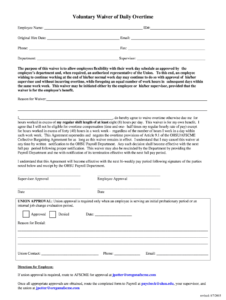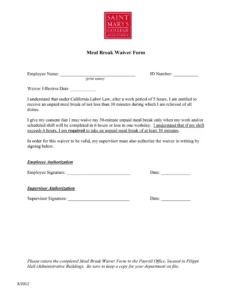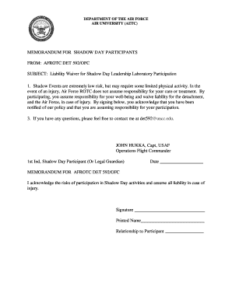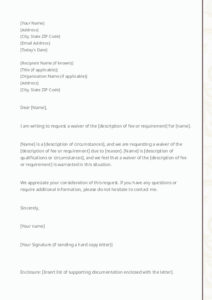Utilizing a standardized form for these requests offers several advantages. It streamlines communication between stakeholders, ensuring all parties are informed and aligned. It promotes transparency and accountability by clearly documenting the decision-making process. Further, it can help ensure compliance with legal and regulatory requirements, mitigating potential disputes or challenges. These forms can be particularly helpful in situations where individualized education programs (IEPs) need adjustments due to unique circumstances or student needs.
The following sections delve deeper into the specific components of these forms, legal considerations, and best practices for their completion and implementation.
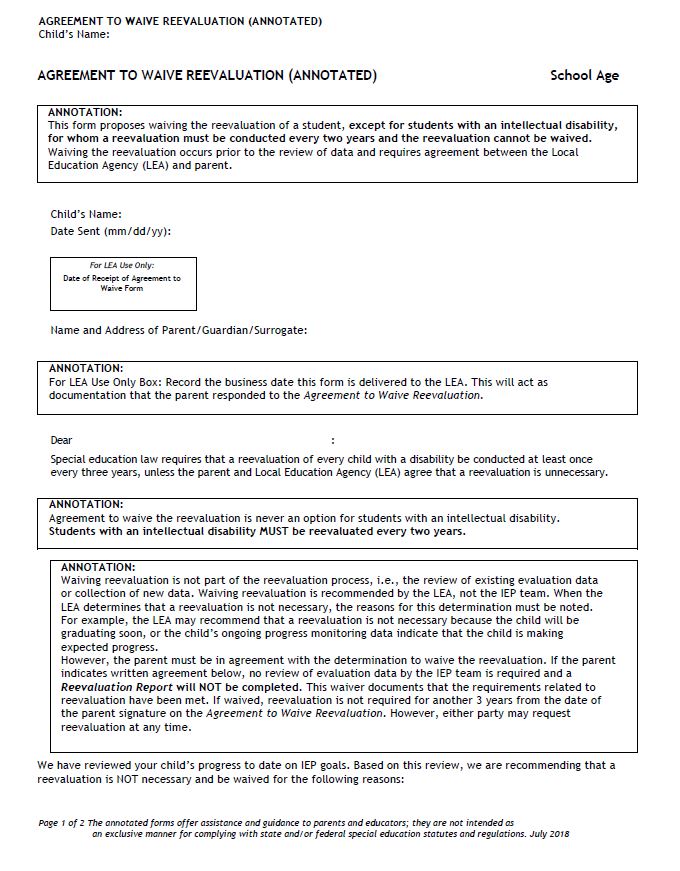
Key Components of a Special Education Waiver Request Form
Well-drafted waiver request forms contain essential elements that ensure clarity, legal compliance, and effective communication among stakeholders. These components facilitate a thorough understanding of the request and its implications for the student’s educational program.
1. Student Information: This section clearly identifies the student, including their name, date of birth, and school identification number. Accurate student identification is crucial for record-keeping and ensuring the waiver is applied correctly.
2. Description of the Standard Service: A precise description of the specific special education service being waived or modified is essential. This clarity allows all parties to understand the nature of the change being requested.
3. Rationale for Waiver/Modification: This section explains the reasons for requesting the waiver or modification. It should detail the specific circumstances justifying the departure from the standard service, supported by relevant documentation or assessments.
4. Proposed Alternative Service/Plan: If the standard service is waived or modified, this section outlines the alternative plan or service to be implemented. This plan should address how the student’s educational needs will continue to be met appropriately.
5. Potential Impacts on the Student: An assessment of the potential impacts both positive and negative of the proposed change on the student’s learning and development is necessary. This analysis informs decision-making and ensures the student’s best interests remain paramount.
6. Signatures and Dates: Designated spaces for signatures and dates from all relevant stakeholders including parents/guardians, educators, and administrators formalize the agreement and document the decision-making process.
7. Duration of the Waiver/Modification: Specifying the period for which the waiver or modification is valid ensures proper review and prevents indefinite alterations to the IEP without reassessment.
8. Review and Renewal Process: Outlining the procedures for reviewing and potentially renewing the waiver ensures ongoing monitoring of its effectiveness and allows for adjustments based on the student’s progress and needs.
These elements work together to create a robust and transparent process for requesting and implementing waivers or modifications to special education services, ensuring appropriate and individualized support for students with disabilities.
How to Create a Special Education Waiver Request Form
Developing a comprehensive and legally sound special education waiver request form requires careful consideration of several key components. A well-structured form ensures clarity, facilitates communication, and protects the rights of all stakeholders.
1. Consult Legal Counsel: Before creating a template, legal counsel should be consulted to ensure compliance with federal, state, and local regulations governing special education services and waivers. This ensures the form adheres to all applicable legal requirements.
2. Clearly Define the Scope: The form should clearly define the types of services that can be subject to a waiver or modification. This clarity helps manage expectations and prevents misuse of the form.
3. Include Essential Information Fields: The form must collect essential information, including student demographics, the specific service being waived or modified, the rationale for the request, the proposed alternative, and potential impacts on the student.
4. Designate Signature Lines: Designated spaces for signatures from parents/guardians, educators, administrators, and any other relevant parties should be incorporated to document agreement and consent.
5. Establish a Review and Renewal Process: The form should specify the duration of the waiver or modification and outline the procedures for review and renewal. This ensures ongoing monitoring and appropriate adjustments based on student needs.
6. Develop Clear Instructions: Clear and concise instructions for completing the form should be included to guide users and ensure accurate and complete information is provided.
7. Ensure Accessibility: The form should be made accessible to all stakeholders, including those with disabilities. This might include providing alternative formats, such as large print or electronic versions.
8. Test and Refine: Before widespread implementation, piloting the form with a small group can identify potential areas for improvement and ensure its practicality and effectiveness. Feedback from users can be invaluable in refining the form’s design and content.
A meticulously designed form ensures a consistent and transparent process for requesting and granting waivers or modifications, safeguarding student interests and facilitating effective communication among all involved parties. Regular review and updates based on legal changes and user feedback are vital to maintaining the form’s relevance and efficacy.
Standardized documentation for requesting exceptions to standard special education services provides a crucial framework for ensuring legal compliance, promoting transparency, and safeguarding student interests. Careful consideration of key components, including clear descriptions of services, rationales for requests, proposed alternatives, and potential impacts, is essential for developing effective and legally sound documentation. Consultation with legal counsel and ongoing review of these documents are vital for maintaining alignment with evolving regulations and best practices.
Effective implementation of these procedures requires ongoing collaboration among parents, educators, and administrators. A commitment to open communication and adherence to established protocols contributes to a more equitable and supportive educational environment for students with disabilities. Ultimately, the focus remains on ensuring that each student receives appropriate and individualized support to reach their full potential.
